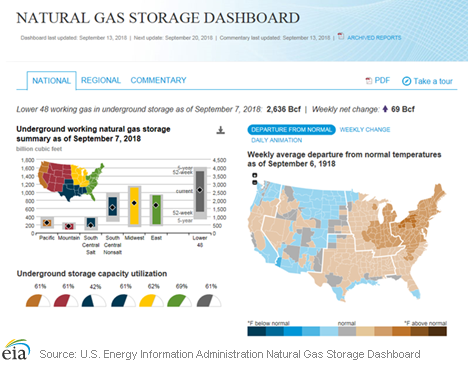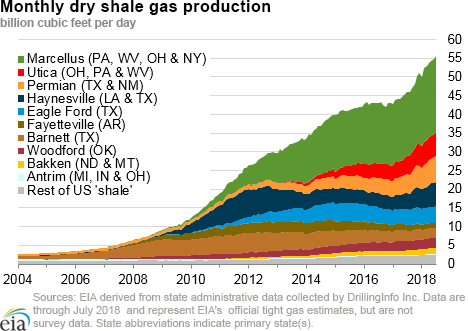In the News:
EIA introduces interactive dashboard detailing natural gas storage activity
EIA has developed an interactive dashboard that provides daily and weekly contextual information to the Weekly Natural Gas Storage Report (WNGSR). The new dashboard provides a comprehensive method for identifying Lower 48 and regional storage activity and the key market fundamentals that affect underground natural gas storage inventories.
The WNGSR is one of the U.S. government's Principal Federal Economic Indicators (PFEI)—key statistics that provide insight into the U.S. economy. Most of these indicators, which include metrics such as employment, international trade, housing construction, and crop production, are released quarterly or monthly.
We will post updates to the dashboard in the mid-afternoon on the same day each week that we release the latest weekly natural gas storage estimates, which is usually on Thursday. The dashboard will follow the same holiday reporting schedule as does the WNGSR.
The dashboard includes the Lower 48 states and regional natural gas storage inventories, net inventory changes, and utilization indicators. Other features and metrics include temperature visualizations, estimated natural gas consumption by sector, net exports, and futures prices.
The information sources we use are a combination of EIA and third-party data Key sources of non-EIA data include temperature data from the National Oceanic and Atmospheric Administration (NOAA), natural gas demand and import/export data from OPIS PointLogic, and natural gas futures prices from CME Group and Bloomberg.
We have incorporated many interactive features into the dashboard, such as the ability to select national or regional information, choose specific years or ranges, animate trends, and download selected data series or images. In addition to the data visualizations, the commentary tab provides more context on recent natural gas storage-related market conditions. These short articles will focus on many aspects of the natural gas storage market, such as potential drivers of changes in storage inventories, occasional details on EIA-derived storage statistics, and trends on natural gas storage infrastructure.
Overview:
(For the Week Ending Wednesday, September 12, 2018)
- U.S. natural gas spot prices fell at most locations this report week (Wednesday, September 5 to Wednesday, September 12). Henry Hub spot prices decreased from $2.94 per million British thermal units (MMBtu) last Wednesday to $2.93/MMBtu yesterday.
- At the New York Mercantile Exchange (Nymex), the October 2018 contract price rose 3¢ from $2.795/MMBtu last Wednesday to $2.829/MMBtu yesterday.
- Net injections to working gas totaled 69 billion cubic feet (Bcf) for the week ending September 7. Working natural gas stocks are 2,636 Bcf, which is 20% lower than the year-ago level and 18% lower than the five-year (2013–17) average for this week.
- The natural gas plant liquids composite price at Mont Belvieu, Texas, rose by 58¢, averaging $10.41/MMBtu for the week ending September 12. The price of natural gasoline fell by 2%. The price of ethane, propane, butane, and isobutane rose by 20%, 1%, 1%, and 8%, respectively.
- According to Baker Hughes, for the week ending Tuesday, September 4, the natural gas rig count increased by 2 to 186. The number of oil-directed rigs fell by 2 to 860. The total rig count stayed at 1,048.
Prices/Supply/Demand:
National benchmark spot price decreases with mixed temperatures. This report week (Wednesday, September 5 to Wednesday, September 12), Henry Hub spot prices fell 1¢ from $2.94/MMBtu last Wednesday to $2.93/MMBtu yesterday, reaching a weekly low of $2.84/MMBtu on Friday. Temperatures were cooler than normal across most of the country, but slightly warmer than normal west of the Rockies and in the Southeast.
At the Chicago Citygate, prices decreased 15¢ from $2.87/MMBtu last Wednesday to $2.72/MMBtu yesterday.
California citygate prices decrease. Prices at PG&E Citygate in Northern California fell 12¢, down from $3.21/MMBtu last Wednesday to $3.09/MMBtu yesterday. Prices at SoCal Citygate decreased steadily throughout the week, down 71¢ from $4.26/MMBtu last Wednesday to the low of $3.55/MMBtu yesterday. Southern California Gas Company (SoCalGas) has been working to maximize storage injections ahead of peak winter demand. As of yesterday, SoCalGas’s inventories were at 78.2 Bcf, the highest level for the year, according to publicly available data from the SoCalGas electronic bulletin board, ENVOY.
Northeast prices decrease. At the Algonquin Citygate, which serves Boston-area consumers, prices went down 36¢ from $3.11/MMBtu last Wednesday to $2.75/MMBtu yesterday. At the Transcontinental Pipeline Zone 6 trading point for New York City, prices decreased 15¢ from $3.06/MMBtu last Wednesday to $2.91/MMBtu yesterday, reaching a weekly low of $2.50/MMBtu on Friday.
Appalachian prices decrease. Tennessee Zone 4 Marcellus spot prices decreased 30¢ from $2.49/MMBtu last Wednesday to $2.19/MMBtu yesterday, with a low of $2.16/MMBtu on Friday. Prices at Dominion South in southwest Pennsylvania fell 35¢ from $2.58/MMBtu last Wednesday to the weekly low, $2.23/MMBtu, yesterday.
Early Monday morning, a 24-inch natural gas gathering line that feeds into the Revolution pipeline in Beaver County, Pennsylvania, exploded. Energy Transfer Partners issued a statement to a local news outlet reporting that the incident “was detected by our monitoring system, which triggered the closing of valves to isolate the line.” The fire was contained within three hours; the line has been isolated and depressurized. A landslide in the vicinity of the pipeline may have been the cause, according to Energy Transfer Partners. No service disruptions have been reported. The Pennsylvania Public Utility Commission is conducting an investigation.
Permian basin spot prices decline with a wide differential to Henry Hub spot prices. Prices at the Waha Hub in West Texas, which is located near Permian Basin production activities, averaged $2.02/MMBtu last Wednesday, 92¢ lower than Henry Hub prices. Yesterday, prices at the Waha Hub averaged $2.00/MMBtu, 93¢ lower than Henry Hub prices.
Hurricane Florence approaches the Carolinas. Hurricane Florence is set to make landfall in the Carolinas today as a Category 2 storm. Evacuation orders are in effect for more than one million people, likely affecting power demand. Nuclear energy is the most-used fuel for electricity generation in both North Carolina and South Carolina. As of Wednesday, no nuclear outages have been reported. EIA’s Energy Disruption energy infrastructure maps are available with real-time storm information.
Nymex futures prices increase. At the Nymex, the price of the October 2018 contract increased 3¢, from $2.795/MMBtu last Wednesday to $2.829/MMBtu yesterday. The price of the 12-month strip averaging October 2018 through September 2019 futures contracts climbed 1¢ to $2.765/MMBtu.
Overall supply is flat. According to data from PointLogic Energy, the average total supply of natural gas remained the same as in the previous report week, averaging 87.8 Bcf/d. Dry natural gas production increased 0.4% week over week, exceeding 83 Bcf/d for the first time on a weekly basis. Average net imports from Canada decreased by 11% from last week.
Overall demand is down despite increases in the residential and commercial sectors. Total U.S. consumption of natural gas fell by 1% compared with the previous report week, according to data from PointLogic Energy. Natural gas consumed for power generation declined by 8% week over week. Industrial sector consumption increased by 1% week over week. In the residential and commercial sectors, consumption increased by 26%. Natural gas exports to Mexico decreased 7%.
U.S. liquefied natural gas (LNG) exports increase week over week. Six LNG vessels (four from the Sabine Pass liquefaction terminal and two from Cove Point) with a combined LNG-carrying capacity of 21.2 Bcf departed the United States from September 6 through September 12. Two more tankers (combined LNG-carrying capacity 7.6 Bcf) were loading at Sabine Pass on Wednesday.
Cheniere Energy, the operator of the Sabine Pass liquefaction terminal, has received a letter order from the Federal Energy Regulatory Commission granting approval to introduce feed gas for the commissioning of Train 5. The first LNG production from Train 5 is expected before the end of this year.
Dominion Energy, the operator of the Cove Point liquefaction terminal, activated a Severe Weather Plan in response to approaching Hurricane Florence.
Storage:
Net injections are less than the five-year average. Net injections into storage totaled 69 Bcf for the week ending September 7, compared with the five-year (2013–17) average net injections of 74 Bcf and last year's net injections of 87 Bcf during the same week. Working gas stocks totaled 2,636 Bcf, which is 596 Bcf lower than the five-year average and 662 Bcf lower than last year at this time.
Working gas stocks remain lower than the five-year range, and the deficit continues to grow. The average rate of net injections into storage is 16% lower than the five-year average so far in the 2018 refill season. If the rate of injections into working gas matches the five-year average of 10.8 Bcf/d for the remainder of the refill season, total inventories will be 3,219 Bcf on October 31, which is 341 Bcf lower than the five-year low of 3,560 Bcf. In the Lower 48 states, total working gas stocks are currently 232 Bcf lower than the five-year range in the East region and 85 Bcf lower than the five-year range in the Midwest. The South Central region posted working gas stocks that are 18 Bcf lower than the bottom of the region’s five-year range, and its nonsalt facilities are 17 Bcf higher than their lower bounds. Total working gas stocks in the Lower 48 states are now 190 Bcf lower than the five-year range.
The average January 2019 futures contract price is trading at a lower premium to the average spot price than last year at this time. Price differences between the spot price and the futures prices at the Nymex indicate limited economic incentives for injections into working gas. During the most recent storage week, the average natural gas spot price at the Henry Hub averaged $2.93/MMBtu, and the Nymex futures price of natural gas for delivery in January 2019 averaged $3.03/MMBtu, 10¢/MMBtu higher than the spot price. A year ago, the January contract was 42¢/MMBtu higher than the spot price.
Reported net injections into storage match the median of analysts’ expections. According to The Desk survey of natural gas analysts, estimates of the weekly net change from working natural gas storage ranged from net injections of 62 Bcf to 76 Bcf, with a median estimate of 69 Bcf. At the 10:30 a.m. release of the WNGSR, the price of the Nymex futures contract for October delivery at the Henry Hub fell by 1¢/MMBtu to $2.84/MMBtu, with 332 trades trades executed. Prices varied somewhat in subsequent trading, but remained close to $2.84/MMBtu.
Temperatures remain in the higher-than-normal range for the storage week. Temperatures in the Lower 48 states averaged 76 degrees Fahrenheit (°F), 5°F higher than normal and 6°F higher than last year at this time. Temperatures were 1°F higher than those reported for the previous week.
See also:
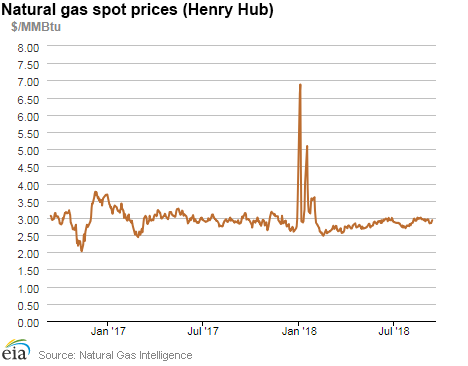
| Spot Prices ($/MMBtu) | Thu, 06-Sep |
Fri, 07-Sep |
Mon, 10-Sep |
Tue, 11-Sep |
Wed, 12-Sep |
|---|---|---|---|---|---|
| Henry Hub |
2.87 |
2.84 |
2.85 |
2.89 |
2.93 |
| New York |
2.84 |
2.50 |
2.99 |
2.96 |
2.91 |
| Chicago |
2.77 |
2.69 |
2.67 |
2.65 |
2.72 |
| Cal. Comp. Avg.* |
2.83 |
2.69 |
2.63 |
2.64 |
2.61 |
| Futures ($/MMBtu) | |||||
| October contract | 2.772 |
2.776 |
2.804 |
2.828 |
2.829 |
| November contract |
2.791 |
2.790 |
2.808 |
2.827 |
2.820 |
| *Avg. of NGI's reported prices for: Malin, PG&E Citygate, and Southern California Border Avg. | |||||
| Sources: Natural Gas Intelligence and CME Group as compiled by Bloomberg, L.P. | |||||
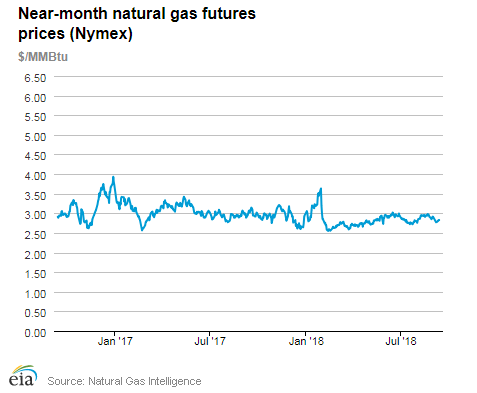
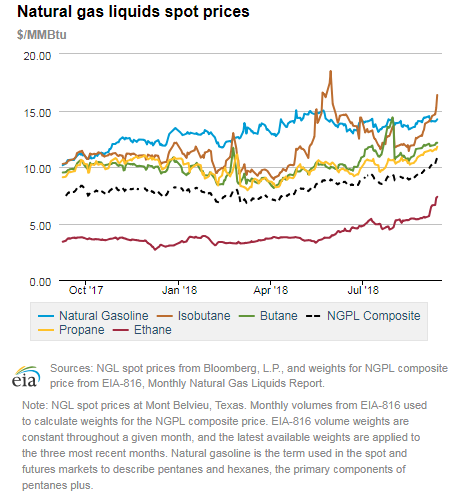
| U.S. natural gas supply - Gas Week: (9/6/18 - 9/12/18) | |||
|---|---|---|---|
Average daily values (Bcf/d): |
|||
this week |
last week |
last year |
|
| Marketed production | 94.6 |
94.3 |
82.5 |
| Dry production | 83.2 |
82.9 |
72.9 |
| Net Canada imports | 4.5 |
5.0 |
5.2 |
| LNG pipeline deliveries | 0.1 |
0.1 |
0.1 |
| Total supply | 87.8 |
88.0 |
78.1 |
|
Source: OPIS PointLogic Energy, an IHS Company | |||
| U.S. natural gas consumption - Gas Week: (9/6/18 - 9/12/18) | |||
|---|---|---|---|
Average daily values (Bcf/d): |
|||
this week |
last week |
last year |
|
| U.S. consumption | 60.1 |
61.0 |
53.8 |
| Power | 31.2 |
34.0 |
25.7 |
| Industrial | 19.8 |
19.7 |
19.9 |
| Residential/commercial | 9.1 |
7.3 |
8.2 |
| Mexico exports | 4.4 |
4.7 |
4.2 |
| Pipeline fuel use/losses | 6.7 |
6.7 |
6.0 |
| LNG pipeline receipts | 3.3 |
3.2 |
1.5 |
| Total demand | 74.5 |
75.6 |
65.5 |
|
Source: OPIS PointLogic Energy, an IHS Company | |||
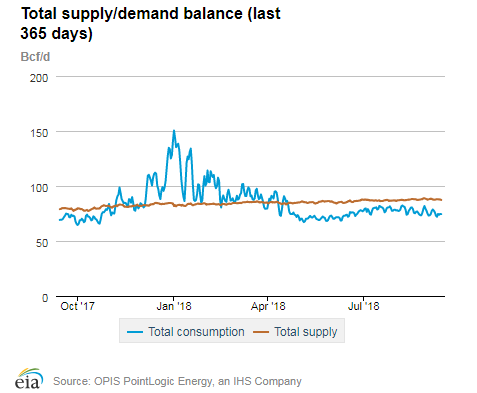
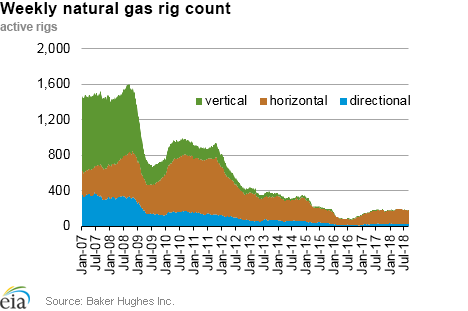
| Rigs | |||
|---|---|---|---|
Tue, September 04, 2018 |
Change from |
||
last week |
last year |
||
| Oil rigs | 860 |
-0.2% |
13.8% |
| Natural gas rigs | 186 |
1.1% |
-0.5% |
| Note: Excludes any miscellaneous rigs | |||
| Rig numbers by type | |||
|---|---|---|---|
Tue, September 04, 2018 |
Change from |
||
last week |
last year |
||
| Vertical | 65 |
-1.5% |
-13.3% |
| Horizontal | 918 |
0.1% |
15.8% |
| Directional | 65 |
0.0% |
-14.5% |
| Source: Baker Hughes Inc. | |||
| Working gas in underground storage | ||||
|---|---|---|---|---|
Stocks billion cubic feet (Bcf) |
||||
| Region | 2018-09-07 |
2018-08-31 |
change |
|
| East | 679 |
659 |
20 |
|
| Midwest | 734 |
702 |
32 |
|
| Mountain | 166 |
162 |
4 |
|
| Pacific | 250 |
246 |
4 |
|
| South Central | 806 |
799 |
7 |
|
| Total | 2,636 |
2,567 |
69 |
|
| Source: Form EIA-912, "Weekly Underground Natural Gas Storage Report" | ||||
| Working gas in underground storage | |||||
|---|---|---|---|---|---|
Historical comparisons |
|||||
Year ago (9/7/17) |
5-year average (2013-2017) |
||||
| Region | Stocks (Bcf) |
% change |
Stocks (Bcf) |
% change |
|
| East | 805 |
-15.7 |
780 |
-12.9 |
|
| Midwest | 901 |
-18.5 |
879 |
-16.5 |
|
| Mountain | 208 |
-20.2 |
195 |
-14.9 |
|
| Pacific | 296 |
-15.5 |
326 |
-23.3 |
|
| South Central | 1,088 |
-25.9 |
1,052 |
-23.4 |
|
| Total | 3,298 |
-20.1 |
3,232 |
-18.4 |
|
| Source: Form EIA-912, "Weekly Underground Natural Gas Storage Report" | |||||
| Temperature – heating & cooling degree days (week ending Sep 06) | ||||||||
|---|---|---|---|---|---|---|---|---|
HDD deviation from: |
CDD deviation from: |
|||||||
| Region | HDD Current |
normal |
last year |
CDD Current |
normal |
last year |
||
| New England | 1 |
-10 |
-27 |
60 |
46 |
50 |
||
| Middle Atlantic | 0 |
-7 |
-24 |
80 |
54 |
71 |
||
| E N Central | 1 |
-10 |
-30 |
77 |
51 |
69 |
||
| W N Central | 4 |
-12 |
-18 |
60 |
25 |
34 |
||
| South Atlantic | 0 |
-1 |
-4 |
108 |
33 |
40 |
||
| E S Central | 0 |
-1 |
-6 |
101 |
33 |
51 |
||
| W S Central | 0 |
-1 |
-1 |
114 |
12 |
24 |
||
| Mountain | 7 |
-14 |
3 |
58 |
5 |
-20 |
||
| Pacific | 2 |
-4 |
2 |
42 |
5 |
-50 |
||
| United States | 2 |
-7 |
-13 |
80 |
30 |
30 |
||
|
Note: HDD = heating degree day; CDD = cooling degree day Source: National Oceanic and Atmospheric Administration | ||||||||
Average temperature (°F)
7-Day Mean ending Sep 06, 2018
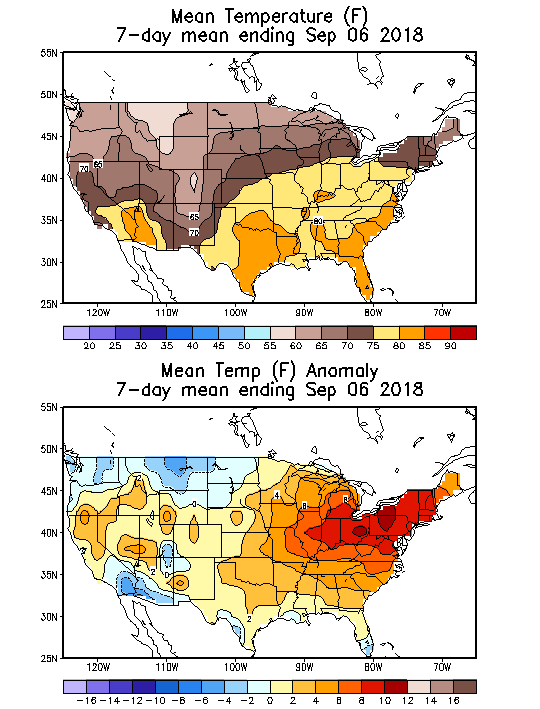
Source: NOAA National Weather Service
Deviation between average and normal (°F)
7-Day Mean ending Sep 06, 2018

Source: NOAA National Weather Service

